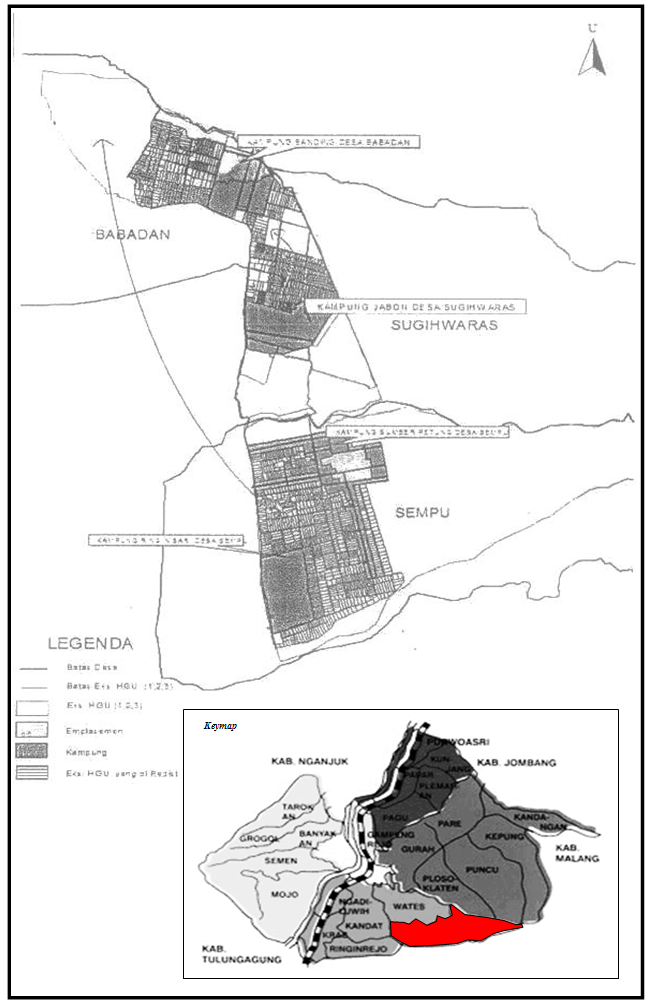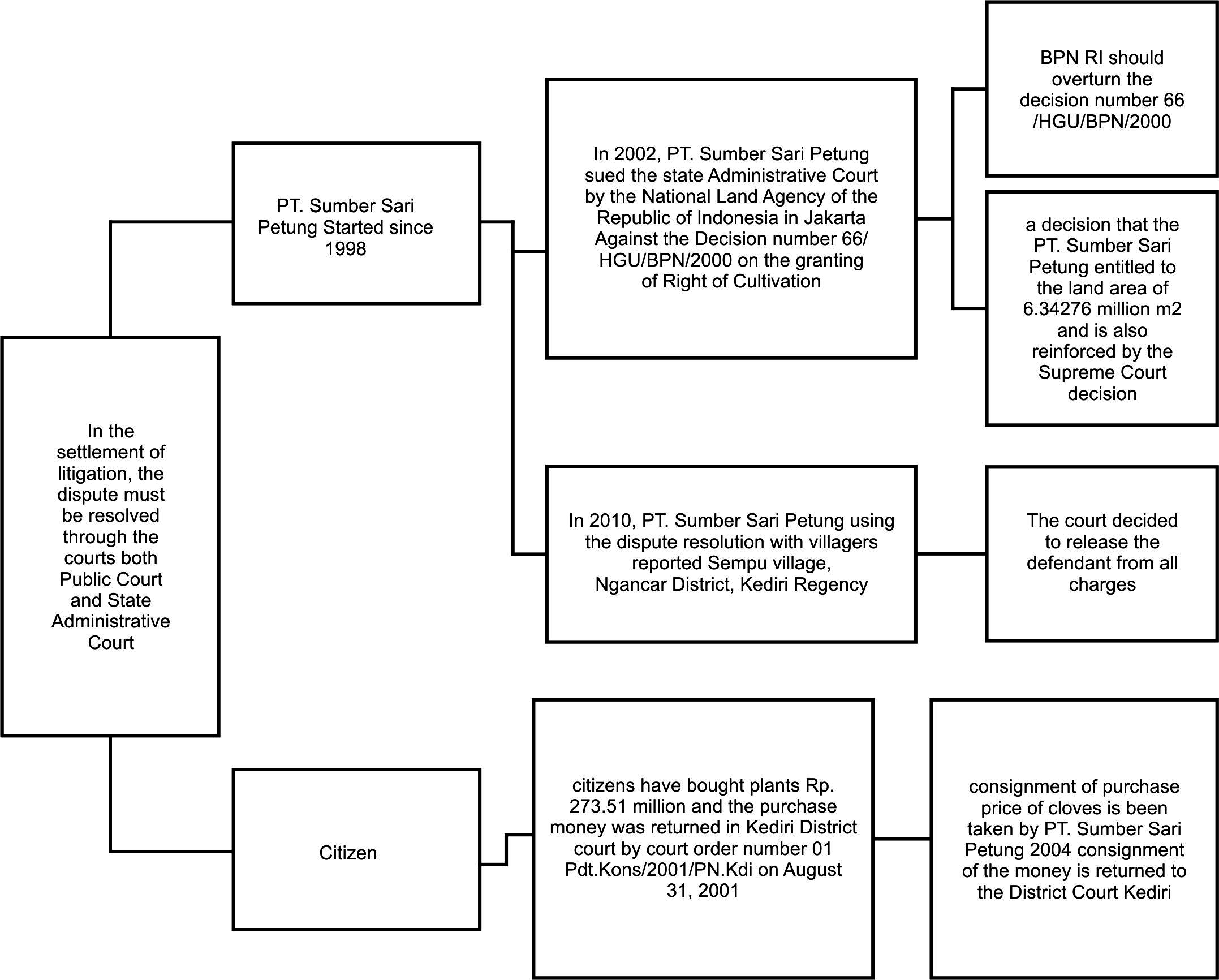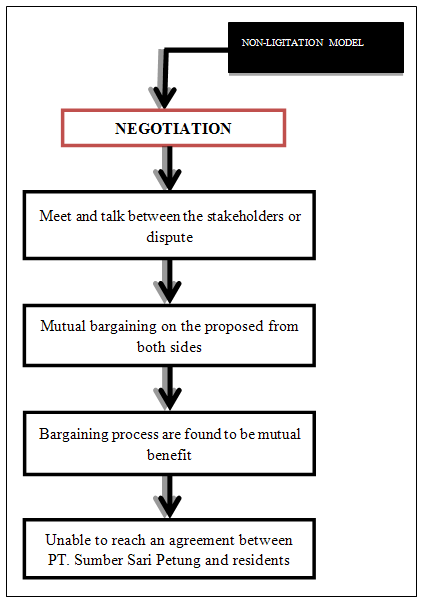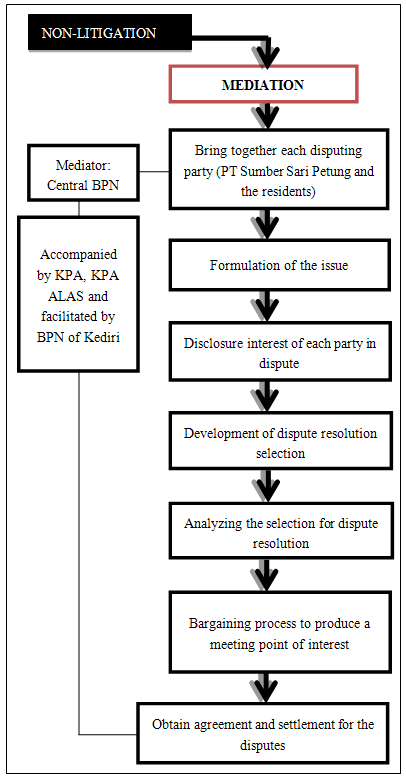-
Paper Information
- Next Paper
- Paper Submission
-
Journal Information
- About This Journal
- Editorial Board
- Current Issue
- Archive
- Author Guidelines
- Contact Us
American Journal of Sociological Research
p-ISSN: 2166-5443 e-ISSN: 2166-5451
2015; 5(1): 1-6
doi:10.5923/j.sociology.20150501.01
Agrarian Dispute Settlement on Land Resources: Right to Cultivate Plantation - (Case Study in District of Ngancar, Kediri Regency)
Nurbaedah1, Kliwon Hidayat2, Soemarno2, Agus Suman2
1Doctoral Program of Environmental Studies, Graduate Program, University of Brawijaya, Malang, Indonesia
2Graduate Program, University of Brawijaya, Malang, Indonesia
Correspondence to: Soemarno, Graduate Program, University of Brawijaya, Malang, Indonesia.
| Email: |  |
Copyright © 2015 Scientific & Academic Publishing. All Rights Reserved.
The presence of former plantation–land disputes, specifically on the right to cultivate between residents of the three villages in Ngantar District with PT Sumber Sari Petung were happened since the time of the new order as the background of the research. This research is conducted to get an overview on the efforts that have been made in resolving agrarian resources disputes in Ngantar District. Interviews were carried out by unstructured or in-depth interviews and guided questions to the Chairman of the Trisakti Society, three village’s heads (Babadan, Sugihwaras, and Sempu), Director of PT. Sumber Sari Petung Kediri, Officer of the Civil and Criminal District Court Kediri, and the Head of the National Land Office in Kediri. The results of the analysis were expected to support the successful efforts for agrarian resource dispute resolution by non litigation way with mediation.
Keywords: Agricultural Resources Disputes, Dispute Resolution, Non-litigation and litigation
Cite this paper: Nurbaedah, Kliwon Hidayat, Soemarno, Agus Suman, Agrarian Dispute Settlement on Land Resources: Right to Cultivate Plantation - (Case Study in District of Ngancar, Kediri Regency), American Journal of Sociological Research, Vol. 5 No. 1, 2015, pp. 1-6. doi: 10.5923/j.sociology.20150501.01.
Article Outline
1. Introduction
- Land dispute is a fairly complex problem involving many stakeholders over the ownership on the land. Ownership of land and agrarian reform is crucial thing to the achievement of certainty, legal protection, justice and prosperity for all Indonesian. Thus land ownership is important for the national development [1]. Numbers of issues listed in the MPR IX 2001 article 2, that the agrarian reform includes a continuous process regards to the restructuring on the control, possession, and utilization of Agricultural Resources (agriculture, forestry, mining, and fisheries). One case of agrarian land dispute is the Right to Cultivate on the former- plantation area in Regency of Kediri, Ngancar District since 1982. The dispute occurred between the villagers of Sempu (Sub-village of Ringinsari and Sumber Petung), Babadan (Sub-village of Sanding), and Sugihwaras (Sub-village of Jambon) with PT. Sumber Sari Petung on the State land area of 6,342,760 m2.According to Decision No. 66/HGU/BPN/2000 about the Grant of Right to Cultivate issued by National Land Office (BPN), the Right to Cultivate the area of 6,342,760 m2 former plantation managed or used by both parties. Details are 3,842,760 m2 of land area were managed by PT. Sumber Sari Petung and the remaining area of 2,500,000 m2 of Land Reform used by residents for agricultural activities. Basically, land reform is a reform of the ownership, control and legal relations related to the cultivation activities. Purpose of land reform is to distribute the land area as the source of livelihood for farming community [2]. Land reform as a policy was taken by the government to improve the productivity of farmers, to create an increase in their welfare [3]. Meanwhile, PT. Sumber Sari Petung assumes that the company is entitled to the 250 ha land area. Because PT. Sumber Sari Petung claimed the BPN in the level of State Administrative, either on appeal and in Supreme Court, then PT. Sumber Sari Petung becomes the favor. However, until now the Supreme Court's decision has not been implemented by the BPN because it involves the cancellation of Decision No. 66/HGU/BPN/2000 about the Grant on Right to Cultivate. On the other side, residents of the three villages in the working area of 250 ha land is based on Decision No. 363 in 2001; and this decision has not been made into object of a dispute or canceled. These conditions give rise to the disputes between citizens and PT. Sumber Sari Petung.Litigation in the courts tend to incapable to resolve the conflict or dispute, in the contrary it generates a new issue because it is win-lose, unresponsive, and time consuming matter. Thus the conflicts solving by informal mediation, would bring together the parties to the dispute with a third neutral party. One method of dispute resolution with this approach is the Alternative Dispute Resolution (ADR) [4]. ADR is considered to be more capable to resolve the disputes related to the public interest in an efficient and effective manner. This method is considered suitable for resolving conflicts or disputes in a comprehensive and flexible way according to the needs and interests of the parties concerned [5].The land dispute that occurs between PT. Sumber Sari Petung with residents is a case of public interest with the long conflict which needs an effective and efficient handling. Thus it can create an agrarian dispute resolution resource on former plantation of land rights to cultivate in Kediri Regency, District of Ngancar.
2. Research Methodology
- The research method consists of data collection and data analysis. Secondary data was analysed by descriptive qualitative.
2.1. Data Collection
- The data was collected using unstructured interview technique with guidelines question (guidelines of the interview). The collected data is information about dispute resolution and settlement which has been reached and produced results in a mutual benefit agreement between residents and PT Sumber Sari Petung. This study located in the village of Babadan, Sugihwaras, and Sempu, Kediri Regency, East Java (Fig. 1).
 | Figure 1. Location of plantation land dispute in Ngancar |
2.2. Data Analysis
- This research is qualitative descriptive study of mediation in agrarian resources on former plantation of land Right to Cultivate located in District of Ngancar. The data results from interviews and primary data described qualitatively. Qualitative analysis was necessary to describe in detail and depth through the sentences [6]. This analysis conducted by detailing the efforts that have been taken to deal with the dispute and compared with theory and previous studies.
3. Results and Discussion
- Based on interviews with several informants, we obtained the following results.
3.1. Litigation Solution
- Litigation puts stakeholders opposing each other; a means of dispute resolution (ultimum remedium) after other alternative dispute resolution did not work [7]. In the settlement of the litigation, the dispute must be resolved through the courts, both General Court and State Administrative. General Court has the authority to accept, investigate, hear and decide the disputes in civil and criminal matters. While State Administrative has the authority to accept, investigate, hear and rule on the dispute with the object of the decision; individual and final.The solution of litigation ever accomplished by PT. Sumber Sari Petung started since 1998 and 1999. The related report from PT. Sumber Sari Petung to the authorities for criminal acts was committed by some villagers of Sempu. Regency of Kediri Court case No. 153/Pid.S/1999/ PN.Kdr stated that the defendant was convicted of a crime of violation on the provisions of Article 363 about the Penal Code with imprisonment of three months and fifteen days.Solution of litigation is also conducted through a lawsuit in State Administrative level by PT. Sumber Sari Petung against the National Land Office of Indonesia in Jakarta. The lawsuit in the 2004 was on the Decision No. 66/HGU/BPN/ 2000 on the granting of Right to Cultivate dated December 18th, 2000 with decision that PT. Sumber Sari Petung entitled to the land area of 6,342,760 m2. It finally amplified by the Supreme Court decision in 2008 which basically contains the BPN decision to cancel the decision No.66/HGU/BPN/2000. Thus, based on the decision of the Supreme Court, PT. Sumber Sari Petung legally entitled to the concession area of 6,342,760 m2 land.
 | Figure 2. Flow Model on the Litigation Disputte Settlement of Right To Cultivate |
- Then in 2010, PT. Sumber Sari Petung using dispute resolution to report the villagers of Sempu, named Suselo as suspects/defendants who allegedly committed the crime by violating the provisions of the Law and the Criminal Code of Plantation. However, the lawsuit of PT. Sumber Sari Petung is failed because the court decided to release the accused Suselo, because it is not categorized as a criminal act, but in the category of civil disputes.Otherwise, the settlement of litigation by citizens to the dispute was based on the rulings of the Court. The citizens have to buy the ex-cloves plantation land area with Rp. 273,510,000 and the purchase money was paid in Regency of Kediri Court by a court decision No. 01/Pdt.Kons/2001/ PN.Kdi on August 31st, 2001; No. 01/Pdt.Kons/2002/ PN.Kdi and No. 02/Pdt.Kons/2002/PN.Kdi dated March 1st, 2002. The purchase price of consignment on cloves plantation is taken by PT. Sumber Sari Petung through Priyo Sulistyo Budi, SH by memorandum No. 01/Kons/2002/PN.Kdi and No. 02/Kons/2002/PN.Kdi on March 14th, 2004. However, the consignment money that taken by PT. Sumber Sari Petung returned to the Court of Kediri Regency in the sam year and PT. Sumber Sari Petung filed in the BPN of Indonesia.
3.2. Non-Litigation Solution
3.2.1. Negotiation
- The mechanisms of non-litigation dispute resolution off the court conducted through mediation and negotiation. Negotiation is a process in which PT Sumber Sari Petung and conflicting public to meet and talk with the intention to reach an agreement [8]. Negotiation is a process whereby two or more parties of same or opposite interest to meet and talk with the intention to reach an agreement [9]. Preparations include [10]: gather information, set goals, establish priorities, searching on the opponent and the case, developing a negotiation strategy, knowing attachments or limit its mandate, to consider the consequences of failure.Negotiations on the issue of dispute were conducted between the two parties. Both parties act as negotiators, representatives of the community and a lawyer from PT Sumber Sari Petung. The negotiation process does not involve a third party as a mediator. Negotiators from both sides exchanged offer proposal. They bargained to reach an agreement that beneficial to both parties. But in this case, the negotiations did not reach an agreement. This happens because public deals that the land concession is returned to the public and PT Sumber Sari Petung disagree the deals. The company offers for the land managed by PT Sumber Sari Petung. The second deal is considered not to be beneficial for both sides. At the end of the non-litigation process through negotiation cannot resolve the disputes (Fig. 3).
 | Figure 3. Chronology Model on the Non-Ligitation Dispute Settlement of Right To Cultivate with Negotation |
3.2.2. Mediation
- In addition from negotiation, non-litigation solutions are accomplished by mediation. Mediation is a dispute resolution through the bargaining process of the stakeholders which assisted by a mediator. The mediator is neutral and fair, which serves to assist the parties in finding a wide range of possibilities for conflict resolution [11]. We found that non-litigation solutions were accomplished by both sides after PT. Sumber Sari Petung using litigation efforts by the General Court and the Administrative Court of the State. Thus even PT. Sumber Sari Petung entitled to the Right to Cultivate the area of 6,342,760 m2 based on the decision of the Supreme Court, the disputes has been show no sign of resolved.Residents of three (3) villages were represented by local government, e.g. National Human Rights Commission, the Parliament, the Central BPN, Regional BPN and BPN of Kediri; in order to facilitate the non-litigation settlement/ peace or deliberation. Because the legal mechanisms cannot be maximal, then PT. Sumber Sari Petung and residents of three (3) villages accompanied by KPA, KPA ALAS and facilitated by Central BPN and BPN of Kediri as the mediator. The mediation effort obtained the settlement for the disputes [12]. Chronology in the mediation process is shown in Figure 4.
 | Figure 4. Chronology Model on the Non-Litigation Dispute Settlement of Right To Cultivate with Mediation |
3.3. Settlement of Dispute through Agrarian Reform
- Agrarian Reform includes a continuous process regards to the restructuring of control, ownership and utilization of resources in the core of agrarian land redistribution [13]. While the core objects of land reform is the redistribution of Right to Cultivate on the land area that expired and not renewed. It ultimately controlled by the nation/state.In agrarian dispute on the Right to Cultivate of PT. Sumber Sari Petung and the residents that mediated by BPN RI and BPN of Kediri followed up with the implementation of land redistribution of 250 ha. The practice through the preparation stages, counseling, identification of the subject (share croppers) and objects (arable land), Land Reform Advisory committee hearing, selection of candidates redistribution, making the map of land area, the issuance of the Decision to Grant Ownership, Bookkeeping Rights and Certificate Issuance financed by DIPA BPN 2012.While the proposed location of land redistribution in whole reform object as ±1,766 areas with details: Babadan Village with ± 535 areas, Sugihwaras Village with ± 449 areas and Sempu Village for ± 782 areas. The terms of objects of land redistribution in the land reform is clear and clean (legally, and physically there is no objection or claim from the other party. It also did not in dispute and conflicts and exclude forest areas), did not adhering to a case (uncertified) and the use of land for agriculture (good for paddy field/ tegal).Terms of the recipient of land redistribution object in land reform beneficiaries are farmers as referred to Article 8 and 9 of Government Regulation No. 224, 1961. Article 8 set the priority order of the land receiving: tenants who work the land in question; farm workers remain on the former owner, who worked on the concerned land; workers remain on the former owner of the concerned land; tillers who have up to 3 years of working on the land in question; tenants who worked for land rights of the owner; tiller lands by the government was given another designation pursuant to Article 4 (2) and (3); tenants who cultivated fields of less than 0.5 ha; owner of the less than 0.5 ha land and farmers or other workers. Pursuant to Article 9, the farmers referred in Article 8 must comply:General requirements; Indonesian citizen, residing in the district location of land in question and powerful work in agriculture or at least 18 years age or married Specific requirements; for farmers who belong to the priority tiller who worked the land in question, the former farm workers remain on the owners who work the land in question, tiller who work the land rights of the owner, tiller lands by the Government given the other uses and tiller who cultivated less than 0.5 ha fields has been working at least 3 years in a row.The mastery identification on the Village land area in Land Reform Object at Sempu, Ngancar District, Kediri Regency obtained the following data. The objects of extensive land reform include 128.9840 ha land area, 782 areas, and 707 households tiller. The 782 areas or 707 KK serfs were clarified with the identification of Regent Decree No. 363 of 2001 as follows. Up to 591 areas still or as Regent Decree No. 363 of 2001, a total of 125 areas of land tiller have died; the land that the heirs requested, and 69 areas history of the land-mastery for public facilities. Public facilities are for endowments and village government, the land has been diverted, the applicant did not felt controlled or cultivate the land. The name does not match the name of the heir to the parent households, the number of heirs did not correspond to reality, and the recipient is domiciled outside the territory of inheritance.The object of land redistribution in land reform of this research, the former Right of Cultivation of land PT. Sumber Sari Petung for area of 250 ha that are released on the state and controlled by the state. Then it is redistributed to the villagers of Babadan, Sempu and Sugihwaras in Ngancar District, Kediri Regency and PT. Sumber Sari Petung obtain the renewal Right to Cultivate of 397 ha area. It is expected that the resources of agrarian conflicts in the former of land Right of Cultivate between PT. Sumber Sari Petung and Villages of Babadan, Sempu and Sugihwaras in Ngancar District, Kediri Regency resolved and the conflicts on the Right to Cultivate on the land will not happen again in the future. Flow of this agrarian reform dispute resolution is shown in Figure 5.
 | Figure 5. Flow Model of the Dispute on Settlement Right to Cultivate by Agrarian Reform |
4. Conclusions
- We concluded that to deal with the issue of dispute settlement on the right to cultivate in Ngancar District processed through non-litigation or consensus. Although the dispute trough the mechanism of civil law and criminal law (litigation), it did not work out. Thus the three villagers accompanied by KPA and KPA ALAS, and facilitated by central BPN and Kediri BPN as a mediator, then the agreement efforts showed better resolution on the settlements of the disputes.
 Abstract
Abstract Reference
Reference Full-Text PDF
Full-Text PDF Full-text HTML
Full-text HTML